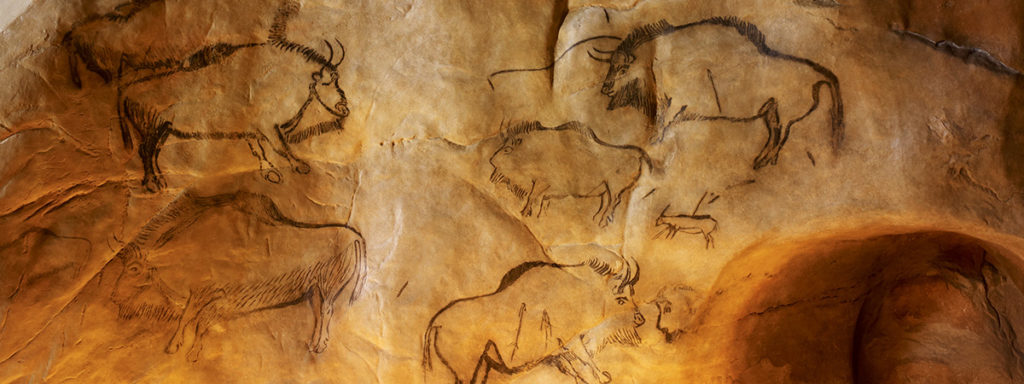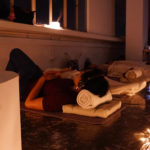02
Oct
2017
Magical acoustics of the prehistoric caves

Reading Time: 5 minutes
Introduction
Prehistoric caves usually have a story to tell. We are all familiar with the stunning prehistoric paintings found in caves across the world: Lascaux, Altamira, Bhimbetka, and many more. This artistic breakthrough in human evolution allows us to imagine how our ancestors lived.
But how much do you know about the acoustics of these caves? Is there any connection between the acoustics and the prehistoric paintings and rituals held within? Many acousticians, sound archaeologists, and anthropologists are studying the acoustics of prehistoric caves nowadays. They believe that acoustics can lead to valuable insights on the behaviours of the prehistoric man. This article will go through some of the theories tackling the use of sound in the prehistoric caves.
Prehistoric auditoriums
It is not difficult to imagine that caves have good acoustics; recent studies done in Italian and Spanish caves back up this theory. The acoustic experiments reveal that, because of the shape and materiality of the caves, they were most likely used in prehistoric times as some sort of auditorium. Although the measured values show that some of the cave chambers are not optimal for speech understanding, most of them have fair reverberation time (0.45–0.60) and are even optimal for classical concerts (2dB<C80< 2 dB for C 80 values). In fact, these values are not far from the criteria reported in the contemporary literature for auditoriums and concert halls. Plus, the limestone that constitutes the caves is porous and thus, soundproof. And the caves’ stalactites and stalagmites may be assimilated to diffusing surfaces, according to the authors of the study.
However, do not be tricked! Our prehistoric ancestors probably didn’t host classical music concerts back in the day. Professor Rupert Till explains that we may have to think in terms of sounds, rather than music or symphony, in classical terms:
We may have to think about sound-making, rather than music with performers and audiences. There is generally little background noise, so even the sound of footsteps might have seemed loud. If there were rituals, everyone might have participated by clapping, stomping, banging or singing….Some of the earliest musical instruments have been found in caves. Simple tools like bone scrapers, seashells, and river stones.
Human echolocation
A famous Russian sound anthropologist, I. Reznikoff, has been studying sounds in the prehistoric caves since 1983. He was able to locate the famous cave paintings in complete darkness by using his voice to gauge the resonance of the spaces. And he also believes that prehistoric men were using their voices to navigate the caves as well.
Because our vision is limited by darkness, resonance is the only way to know how long or deep space ahead is. This represents one use of the voice and of the hearing as a sonar device, and there is no doubt that Palaeolithic tribes who visited and decorated the caves proceeded in this way; indeed, in irregular shaped galleries or tunnels, neither oil lamps nor even torches light further than a few meters. This sonar method works: in many cases, proceeding into the direction of the strongest answer of the cave will lead to the locations of paintings.
This way of moving around in darkness demonstrates the main importance of sound in discovering space and in proceeding through it; to be sure, it reminds one of the first perception of space the child has in the world of the mother’s womb.
Iegor Reznikoff, “On Primitive Elements of Musical Meaning”, JMM: The Journal of Music and Meaning 3, Fall 2004/Winter 2005
Acoustic landmarks
Crawling in the dark tunnels of the prehistoric caves, towards the direction of the richest echo, one can find various red dots. Located in the walls or the ceiling of the tunnels, they are positioned in spots of maximum resonance.
While their function is still a mystery, it is believed that they were used as acoustic landmarks. Reznikoff explains that they could have marked the way for further exploration or represented a point for rituals or initiation processes related to sound. According to him, at the highest point of resonance, our body starts to vibrate together with the ground, the earth, the darkness and the depth of the sound.
Because of the resonance, the whole body is implicated, sometimes in a subtle way. The approach is essentially physical; in this respect, we may say that the sounds and the whole situation are primitive. Since both the body and the cave vibrate we can speak of an earth or mineral meaning of sound.
Iegor Reznikoff, “On Primitive Elements of Musical Meaning”, JMM: The Journal of Music and Meaning 3, Fall 2004/Winter 2005
Painted chambers – the places where visible and invisible meet
Naturally proceeding in the direction of the strongest sound response, we arrive at the location of the cave paintings. Most of these paintings depict animals and are believed to symbolize important prehistoric rituals:
A ritual dedicated to the animal is best performed in such a place since a ritual is always done with the chant, sounds, and possibly dances if space is large enough. In a large hall, such as the Salon Noir in Niaux, the Hall of Paintings in the Kapova cave, or the Main Hall in the Isturitz cave (Pays Basque), where flutes were found (Buisson 1990), real ceremonies with voices, including female ones, flutes, etc., were probably carried out.
Iegor Reznikoff, “On Primitive Elements of Musical Meaning”, JMM: The Journal of Music and Meaning 3, Fall 2004/Winter 2005
Around the location of the paintings, the sound serves the purpose of magic more than functionality (unlike in the case of echolocation). Certain sounds like growls, mooing, bison-like lows, stag-like bells or lion’s roars, are resonated all throughout the whole gallery of the cave.
Reznikoff connects this effect to some famous shamanic possessions or trances. By imitating the animal sound and identifying with them, the Siberian Shaman reaches deeper states of consciousness needed for his vision–this is what he calls the animal meaning of sound.
Recent experiments
In the ’80s, one of Reznikoff’s main discoveries was that the density of pictures in a location of a cave is proportional to the quality of the resonance of this location.
Through years of research, he also managed to prove the awareness possessed by the tribes decorating the caves of its sound quality and resonance. However, his research was based only on voices, hands and sometimes whistles.
Looking for more scientific proof, acoustic anthropologist Rupert Till decided to conduct similar experiments–this time with more high-tech equipment. Inspired by Reznikoff’s brilliant propositions, he used a laptop and loudspeakers to map the acoustic fingerprints in the Cantabrian Caves of Spain. Rather than decrypting deep meanings of sound, Till organized his research as an art/science project.
Using the acoustic properties of the caves, he collaborated with a group of acousticians, singers, artists, and anthropologists in an effort to recreate events from prehistoric times.
One thing did remain common for many researchers around the world: certain sounds, when played in the prehistoric caves seemed to bring the environment to life
Check out Till’s project here:
Bonus!!! The caves play themselves
An interesting remark from a recent interview with sound anthropologist Rupert Till is that the cave seems to “play” itself. Since the prehistoric caves are very secluded, they are also pretty quiet; almost no background noise at all. Any sound source or event in the space is immediately amplified to the point of being dramatical. With this magnification, a simple drop of water falling from the ceiling onto a stalagmite could sound like an instrument. In addition, some of the stalagmites and stalactites were marked with red paint in prehistory. When the musicians struck them, they emitted sounds similar to that of a xylophone. Indeed, these prehistoric caves work as an instrument, playing and being played, at the same time.
Do you like articles that evoke an environment with acoustics? Check this out
Write for us!
Do you have any interesting articles that you would like to share? Come contact us at [email protected]





